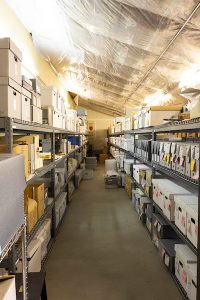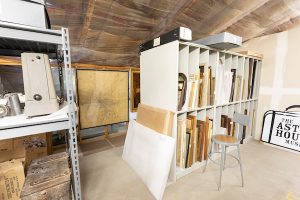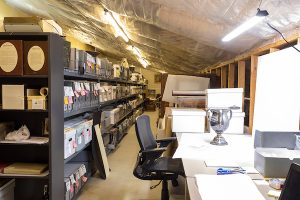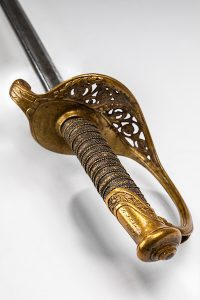
View of collection storage located at Denver West Office Park. This is one of two spaces donated to the City of Golden for museum collection storage. Photo by Justin LeVett.
Overview
Eighty-one years ago, Golden History Museum & Park began collecting artifacts, photographs, and archives to document and preserve Golden’s past. Today, the museum houses over 16,000 objects and is the largest, richest collection of Golden history. However, over eight decades of management shifts, location moves, evolving collecting and record-keeping practices, institutional mergers, and technological advancements have resulted in a fractured, incomplete, and difficult-to-search collections database. Today, Museum staff are undertaking a major collection inventory to improve, refine and make publicly accessible the City’s amazing heritage.
Why do a collection inventory?
Inventories are important for verifying what we actually have in the collection. We can have the greatest artifacts, but if we don’t have documentation about what they are or why they are important, what is the point of even having them? Inventories are excellent for security—they help us to check in on the collection. We can determine if location information is accurate, if the condition of an object has changed, and if the description matches the actual item. An inventory also helps us determine if collections are still relevant to the collection scope.
What are the goals of the inventory project?
GHM&P’s overall goal is to build the highest quality, most accessible collection possible for the Golden community. By undertaking an inventory we want to understand the breadth of the material in our possession, make sure each record is complete and of the highest quality, and review and understand each object’s condition. Ultimately, the museum wants to develop a long-term preservation plan that prioritizes conservation needs and prepares the museum for a hopefully near-future relocation of the collection to a more suitable long-term collection storage facility.

Art rack purchased about five years ago to store two dimensional framed artifacts. We could use another. Photo by Justin LeVett.
What does the inventory process include?
In sum, our goal is to put our eyes and hands on every single object in the collection and to update each record accordingly. To do so, we have a work plan to open and unpack every box in storage. Staff will make sure each artifact has an object ID number.
We will verify each object number with its corresponding record. If a number cannot be found, a “Found in Collections” number is assigned. Staff will add detail to the record including measurements, an objective description, and photo documentation. Location information with specific room, rack, shelf, and box numbers will be recorded. Each object will be assessed and graded based upon its condition, relevance, and provenance (history). While we anticipate most of the artifacts will remain in the collection, those that are deemed irrelevant or in poor condition could be slated for deaccession—an important tool used for identifying objects for removal and disposal. Last, each object will be rehoused in new archival materials for safe storage.

Staff makes the best of less than ideal working conditions. We just installed an internet connection after nearly ten years. Photo by Justin LeVett.
What are some of the challenges of the inventory?
One of the biggest challenges is that the process is slow and laborious. We estimate it will take 2-3 years to complete the inventory. Opening each box, verifying the records and rehousing requires meticulous attention to detail. Because our collection storage site is not adjacent to the museum, it requires working remotely on laptops with limited connectivity, which slows the process.
Frustratingly, the collections records pertaining to the museum’s “legacy collection” (objects collected by different groups prior to the City’s administration) are in spotty condition. Approximately 2,500 of 16,000 artifacts have no ID number. To make matters worse, the Museum is still recovering from an ownership dispute in 2008 which led to the destruction of database records by the previous museum administration and loss of legacy information.

Detail of the hilt on the Lt. John Larkin Civil War sword. Photo by Justin LeVett.
This is the first inventory conducted under the city’s management. Recovering all of the information lost during the dispute is the ultimate, if unlikely, goal. But, we feel it’s not only worth the effort, but our duty to try. And, it’s very rewarding when you do. For instance, we recently rediscovered a Civil War sword and scabbard with an incomplete record. Through the inventory process, we were able to not only confirm its location, but rebuild some provenance by simply recording the personal detail that was engraved on both the sword and scabbard. Through this process, we were able to confirm a Golden connection that was previously unrecorded. The items belonged to Lt. John T. Larkin who settled here after the war.
How will the community benefit from this project?
The Museum’s collection is a public record. It contains a trove of information for residents, historians, researchers, and posterity. Having a robust historical record, properly archived and tracked artifacts, and an accurate, searchable database will make the objects and information as useful as possible to all people. A prioritized understanding of conservation needs will help guide future actions while removing materials that are irrelevant or in poor condition. It also opens up precious space for future collections. Getting the museum’s house in order now will help prepare for a much needed, although yet unplanned move, to a new, more appropriate collections support center. Lastly, we hope this continues to instill trust and confidence in the community that the museum is caring for the City’s collection according to the highest professional standards and practices.
See progress on the Legacy Collection Inventory Project by exploring the online collection.
